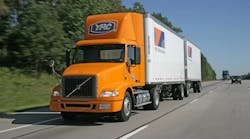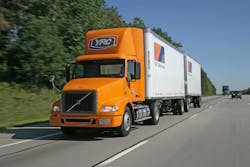This week, consulting firm CarrierDirect is going to issue its semi-annual “market perspective” detailing some of the major trends the firm thinks may affect the freight industry.
And these trends aren’t for the faint of heart, noted Erik Malin, CarrierDirect’s executive VP.
[And he’s got good company in that view of things, as you can see by going here, here and here.]
“The global economy is experiencing a massive shift as traditional economic indicators are proving to be contradictory,” he explains in the firm’s market outlook.
“While nobody is certain on what to expect as our economic future unfolds, winning the freight fight requires creative technology strategies and unique approaches to otherwise standard methodologies,” Malin said.
The title for the company’s latest “perspective” sums up the “uncertainty” facing freight fairly well: “Change is the Only Constant.”
And oh what changes are hurdling towards the transportation business in the U.S. Check out just some the statistics highlighted by Malin:
- By 2020, Millennials will comprise 50% of both the workforce and consumer market. By 2025 that increases to 75% for both.
- Unemployment is down around 5%, yet that’s deceiving, because fewer people overall are working. In fact, the U.S. labor participation rate is hovering between 62% and 63%; a 38-year low.
- U.S. gross domestic product (GDP) increased 2.4% in 2015. In 2016, it’s expected to increase 2.6%; a number CarrierDirect calls “uninspiring.”
- Here’s a topsy-turvy factoid: in 1993, OPEC [the Organization of Petroleum Exporting Countries] produced 50.5% of the world’s oil. By 2014, however, it only produced 35% and its share is still falling.
- Last year alone, global oil prices declined by 30.2%. That is certainly good for trucking’s bottom line (though that might not be completely true, at least according to this story).
- Manufacturing activity dropped 12.5% in 2015; not a good metric where freight activity is concerned.
- And while the U.S. trade deficit declined by 4.9% last year that reduction in imports also doesn’t bode well for freight activity, either.
- Yet truck tonnage ended 2015 up 2.6% over 2014 levels, according to data tracked by the American Trucking Associations (ATA).
So what should motor carriers take away from all of this? Malin offers up a few suggestions:
- Mixed labor market indicators and depressed global oil prices are a tribute to the almost manic market conditions, which is leading many economists to predict only modest growth, at best.
- U.S. global trade is becoming increasingly important and will play a larger role in domestic transportation, especially as the international economy expands.
- Millennials will be a major force for employers to adjust to, but the rewards will be substantially higher for those who embrace the new workforce compared to their competitors who don’t.
- Asset-backed logistics providers will need to develop sophisticated enterprise strategies that maximize service for customers and returns for shareholders, in order to maintain relevancy in the next five to 10 years.
One area where such “sophistication” is going to become more critical encompasses the age-old battleground of freight rates. How can fleets develop better pricing mechanisms to cover their costs and maximize profits?
CarrierDirect touched on that subject last month in a white paper regarding the new focus being placed on “dimensioning technology” in the LTL and third-party logistics (3PL) world; technology that combines precise weight, height, width and depth using laser or photographs, then attaches this detail to a customer’s freight bill for more accurate pricing.That paper – The New Dimension of LTL Pricing – talks about how ensuring the “accuracy” of freight classification can help LTL carriers and 3PLs build better connections with shippers, as well as helping them generate more revenue and profits.
“Although excellent costing tools are utilized, the accuracy of freight classification has been compromised due to changes in packaging, shipment stacking, manufacturing processes and materials, causing a controversial relationship between shippers, intermediaries and carriers,” noted Rich Luhrs, the paper’s author and CarrierDirect’s senior VP. “This technology removes doubt and opportunities for error in freight clarification, thus increasing transparency and data integrity across the supply chain.”
Dimensional data is what helps identify areas of true compatibility – or lack thereof – between carriers and shippers, eases profit pinch points and foster real partnerships, bolstering the industry’s shift toward total supply chain transparency, he said.
“It’s important to note that the cost of dimensioning technology has been decreasing over the years, while its capabilities to minimize exceptions and increase profits for all parties have been increasing, making it more readily available to small, regional and niche carriers,” added CarrierDirect’s Malin.
“As with any technology, however, good communication, new processes and training are the keys to successfully implementing it,” he stressed.
Isn’t that the truth? One thing is for certain: working in the freight business won’t be getting any easier in the months and years to come.




